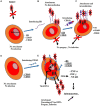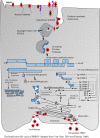Antiviral Strategies of Chinese Herbal Medicine Against PRRSV Infection
- PMID: 32849384
- PMCID: PMC7401453
- DOI: 10.3389/fmicb.2020.01756
Antiviral Strategies of Chinese Herbal Medicine Against PRRSV Infection
Abstract
Bioactive compounds from Traditional Chinese Medicines (TCMs) are gradually becoming an effective alternative in the control of porcine reproductive and respiratory syndrome virus (PRRSV) because most of the commercially available PRRSV vaccines cannot provide full protection against the genetically diverse strains isolated from farms. Besides, the incomplete attenuation procedure involved in the production of modified live vaccines (MLV) may cause them to revert to the more virulence forms. TCMs have shown some promising potentials in bridging this gap. Several investigations have revealed that herbal extracts from TCMs contain molecules with significant antiviral activities against the various stages of the life cycle of PRRSV, and they do this through different mechanisms. They either block PRRSV attachment and entry into cells or inhibits the replication of viral RNA or viral particles assembly and release or act as immunomodulators and pathogenic pathway inhibitors through cytokines regulations. Here, we summarized the various antiviral strategies employed by some TCMs against the different stages of the life cycle of PRRSV under two major classes, including direct-acting antivirals (DAAs) and indirect-acting antivirals (IAAs). We highlighted their mechanisms of action. In conclusion, we recommended that in making plans for the use of TCMs to control PRRSV, the pathway forward must be built on a real understanding of the mechanisms by which bioactive compounds exert their effects. This will provide a template that will guide the focus of collaborative studies among researchers in the areas of bioinformatics, chemistry, and proteomics. Furthermore, available data and procedures to support the efficacy, safety, and quality control levels of TCMs should be well documented without any breach of data integrity and good manufacturing practices.
Keywords: Traditional Chinese Medicine; antiviral activity; bioactive compounds; cytokines; immunity; life cycle; porcine reproductive and respiratory syndrome virus.
Copyright © 2020 Bello-Onaghise, Wang, Han, Nsabimana, Cui, Yu, Zhang, Wang, Li, Cai and Li.
Figures

 Sialoadhesin (CD169) =
Sialoadhesin (CD169) =  Cluster of Differentiation (CD163) =
Cluster of Differentiation (CD163) =  .
.

References
-
- Adiguzel A., Ozer H., Sokmen M., Gulluce M., Baris O. J. (2009). Antimicrobial and antioxidant activity of the essential oil and methanol extract of Nepeta cataria. Pol. J. Microbiol. 58 69–76. - PubMed
-
- Aggarwal B. B., Kumar A., Bharti A. C. (2003). Anticancer potential of curcumin: preclinical and clinical studies. Anticancer Res. 23 363–398. - PubMed
-
- Albina E., Carrat C., Charley B. (1998). Interferon-alpha response to swine arterivirus (PoAV), the porcine reproductive and respiratory syndrome virus. J. Interferon Cytokine Res. 18 485–490. - PubMed
Publication types
LinkOut - more resources
Full Text Sources
Miscellaneous

